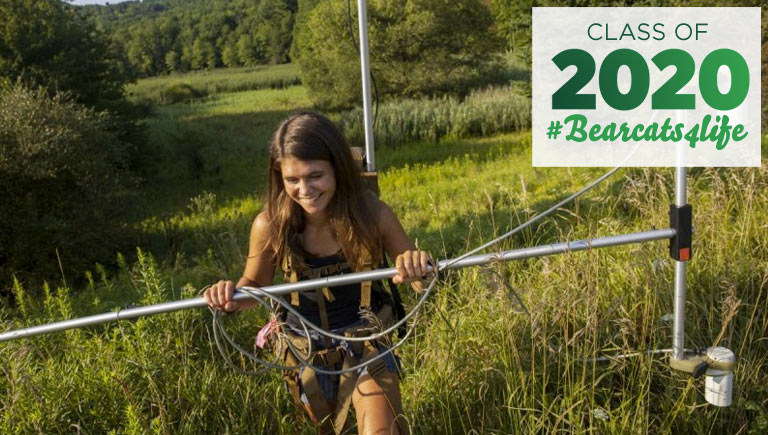Commencement 2020 profile: Natalia Romanzo
Research leads to a new path as an environmental scientist

When she first came to Binghamton University, Natalia Romanzo’s future was a grassy field, open and pathless.
“I never was someone who knew what they wanted to do. I tried everything, from different clubs to research opportunities,” said Romanzo, who earned her bachelor’s in environmental studies and is now finishing her master’s degree in sustainable communities.
The turning point came when she joined the First-year Research Immersion program, which introduced her to geophysics and the use of remote sensing to collect data. She worked with Timothy de Smet, a research assistant professor who directs the Geophysics Remote Sensing Laboratory, and the director of the Sustainable Communities program, Associate Professor George Homsy, during both her undergraduate research and her graduate studies.
A Niskayuna native from the Albany area, Romanzo took the 4+1 path, which combines a bachelor’s degree with an additional year to earn her master’s. Technically, she turned out to be a 3+1, thanks to the college credits she earned in high school.
Why sustainability? “I like an interdisciplinary approach that lets me combine science with my interests in social equity and policy,” she explained.
A new way to detect abandoned wells
For her master’s research, she worked on developing a more efficient method to locate abandoned oil and gas wells by using drones equipped with magnetometers. Abandoned oil and gas wells are a major problem, not only in New York state, but nationally. They can present environmental hazards, such as leaking methane — a potent greenhouse gas — into drinking water and the atmosphere.
There are an estimated 3 million abandoned oil and gas wells in the United States, 69% of which are unplugged. In New York state, they number approximately 50,000, of which 35,000 remain unplugged — and property owners may not even know they exist.
That’s because many were drilled prior to the existence of state regulatory programs and later abandoned by their operators more than a century ago. State and federal regulators are in the process of plugging these wells, but the process is slow; regulators need to locate them first, and that has traditionally involved time-consuming treks on foot, combing the land.
“Some of them don’t have their metal casings anymore; they’re just holes in the ground,” Romanzo explained.
Once discovered, wells are assessed by the state Department of Environmental Conservation (DEC) to determine whether they need to be plugged. Romanzo worked with the DEC on the project, and also tested the technology at a well site outside Buffalo, proving that it works.
In addition to the physical sciences and geographic information systems, Romanzo explored the policy aspect of abandoned wells, as well as budget factors related to remediation. She has presented her work at conferences and also had it published by Fracktracker Alliance, a non-profit organization that supports groups across the United States addressing extraction-related concerns with a lens toward health effects and exposure risks on communities from oil and gas development..
Homsy says that the cutting-edge research Romanzo worked on illustrates the sustainability perfectly. “The work makes solving an environmental problem more economically feasible and potentially takes a major step in reducing otherwise unaccounted for greenhouse gas emissions,” he said.
Trying new things
During her time at Binghamton, Romanzo also participated in several internships, including HeatSmart Southern Tier and Environmental Advocates of New York, which influenced her decision to go into public policy. She also made great friends, starting with her freshman days in Hinman College.
“I think it’s important for students to do more than go to classes. You want to set yourself apart,” she said. “I had a lot of opportunities to do that.”
De Smet was impressed by Romanzo’s motivation and dedication during her time at Binghamton.
“There would be days I’d get into the office and she’d already be in the lab working, and when I finished my 9-5 she’d still be in the lab working,” he remembered. “She somehow managed to also pack in more extracurriculars than a dozen other students combined, while also helping mentor undergraduate students in the lab.”
From a field full of possibilities, Romanzo has found her path — which she will follow west to Ogden, Utah, this June for a new job as an environmental scientist with BAE Systems. The position combines the technical side with policy — exactly what she wants to do.
This new job is just the first step for Romanzo, Homsy said. “At Binghamton University, Natalia acquired the tools she needs to become a leader in sustainability in the years ahead,” he said.
While she’s sad that her time at Binghamton has come to an end, she’s excited for the future.
“I’m constantly trying new things,” she said.

